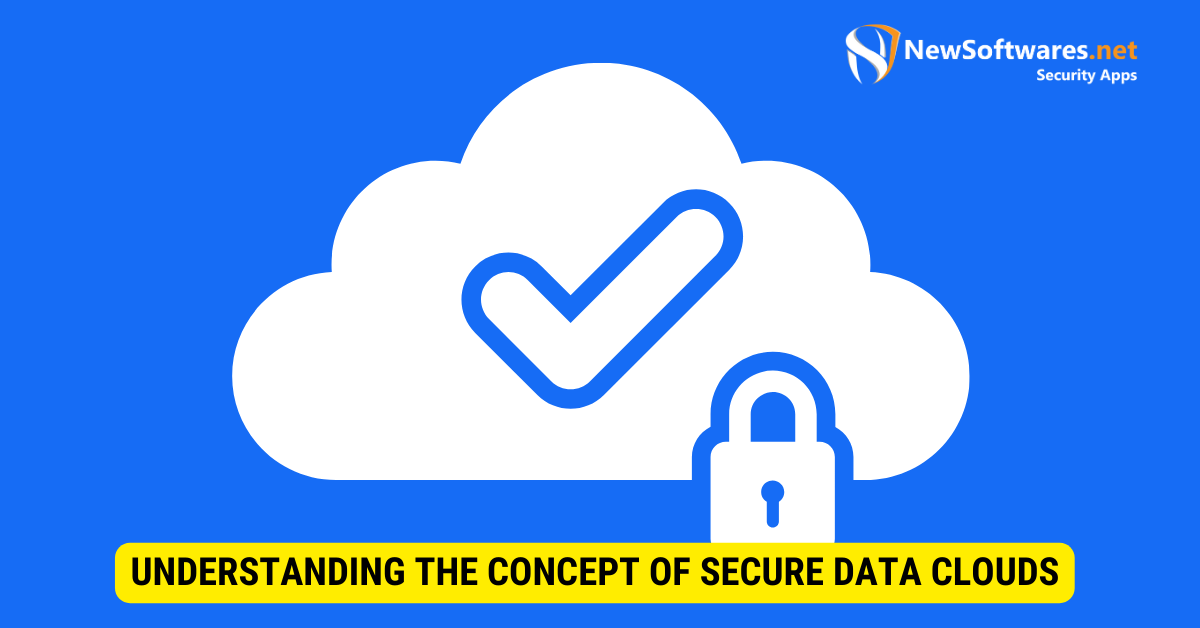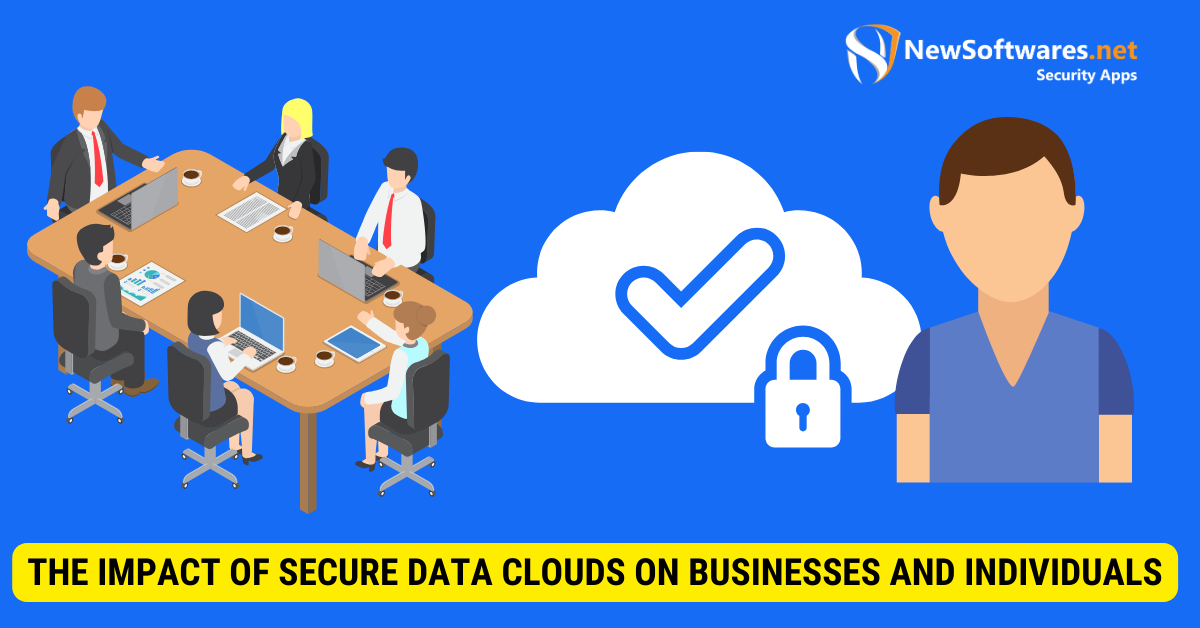The concept of cloud computing dates back to the 1960s, but it wasn’t until the 2000s, with the advent of Amazon Web Services (AWS) in 2006, that the modern secure cloud infrastructure began to take shape.
Secure data clouds have become integral to modern computing, enabling individuals and businesses to securely store and access their data. Understanding the concept of secure data clouds is crucial in appreciating their advancements in data security and cloud computing. We will delve into the evolution of cloud computing, the inception of secure data clouds, their impact on businesses and individuals, and explore the future trends in this exciting field.
Understanding the Concept of Secure Data Clouds

Secure data clouds, also known as secure cloud storage, refer to the secure storage and accessibility of data through cloud computing. Cloud computing involves utilizing a network of remote servers to stock, manage, and process data, allowing users to access their data from anywhere and at any time.
Secure data clouds take this concept further by implementing robust security measures to protect sensitive information from unauthorized access. By employing encryption techniques and stringent access controls, secure data clouds ensure data is safeguarded against cyber fears, such as hacking and data breaches.
But what exactly makes secure data clouds so secure? Let’s delve deeper into the importance of data security in cloud computation.
The Importance of Data Security in Cloud Computing
Data security has always been a critical concern in cloud computing. As businesses progressively rely on the cloud to store vast amounts of sensitive information, enhanced data security becomes paramount. Secure data clouds address this concern by providing a safe environment for storing and accessing data.
One of the key challenges in cloud calculation is ensuring the confidentiality of data. Secure data clouds tackle this challenge by employing encryption techniques. Encryption involves converting data into a form that is unreadable to unauthorized individuals. This safeguards that even if a hacker gains access to the data, they cannot decipher its contents without the encryption key.
Another critical aspect of data security in cloud computing is maintaining data integrity. Data integrity refers to the accuracy and constancy of data throughout its lifecycle. Secure data clouds use various mechanisms, such as checksums and digital signatures, to verify data integrity. These mechanisms detect unauthorized modifications or tampering attempts, ensuring the data remains intact and trustworthy.
Access control is another fundamental component of data security in cloud computing. Secure data clouds implement stringent access controls, allowing organizations to define who can access their data and what actions they can perform. This helps prevent unauthorized individuals from accessing sensitive info and decreases the risk of data breaches.
Data breaches can have severe penalties, ranging from financial losses to reputational damage. By implementing secure data clouds, organizations can mitigate these risks and safeguard their data’s confidentiality, integrity, and availability. This has become particularly crucial with the increasing prevalence of remote work and the need to protect data across various devices and locations.
In conclusion, secure data clouds provide a secure and consistent solution for storing and accessing data in cloud computing. By realizing robust security measures, such as encryption and access controls, secure data clouds offer organizations the peace of mind that their sensitive information is protected against cyber threats. As the reliance on cloud computation continues to grow, the importance of data security in the cloud cannot be overstated.
The Evolution of Cloud Computing
The Early Stages of Cloud Computing
The origins of cloud computing can be traced back to the 1960s when researchers developed the concept of time-sharing, allowing multiple users to access a computer simultaneously. This revolutionary idea paved the way for the distributed computing model that forms the basis of cloud computing.
During the 1990s and early 2000s, advancements in networking and virtualization technologies further propelled the evolution of cloud computing. Companies like Salesforce and Amazon Web Services (AWS) played a pivotal role in popularizing cloud computing by offering scalable and cost-effective solutions. These early adopters recognized the potential of cloud computing to revolutionize the way businesses function.
With the advent of cloud computing, administrations no longer needed to invest in expensive hardware and infrastructure. Instead, they could leverage the power of the cloud to access computing resources on demand. This shift in paradigm allowed businesses to focus on their core competencies while exiting IT infrastructure management to cloud service providers.
The Rise of Data Security in Cloud Computing
As cloud computing gained popularity, concerns over data security emerged. High-profile data breaches and privacy scandals spotlight the need for robust security measures in cloud computing environments. Organizations began to question the safety of their data stored in the cloud.
Realizing the importance of data security, cloud service providers invested heavily in enhancing security protocols. Encryption, access controls, and identity management systems were introduced to protect data from unauthorized access. These improvements laid the foundation for the emergence of secure data clouds.
Moreover, industry standards and certifications were developed to ensure cloud service providers adhere to strict security practices. Organizations could now choose cloud providers that comply with internationally recognized security standards, giving them peace of mind when protecting their sensitive data.
Additionally, advancements in encryption technologies further bolstered data security in the cloud. Strong encryption algorithms and secure key management techniques made it increasingly difficult for malicious actors to compromise the confidentiality and integrity of data stored in the cloud.
Furthermore, cloud service providers implemented robust access controls to ensure that only authorized individuals could access sensitive data. Multi-factor authentication and role-based access control mechanisms became standard practices, adding an extra layer of security to cloud computing environments.
As the cloud computing industry matured, privacy regulations and compliance requirements emerged. Cloud service providers had to adapt to these regulations by implementing stringent privacy measures and offering tools to help organizations achieve compliance with data protection laws.
Overall, the rise of data security in cloud computing has been instrumental in building trust and confidence in the technology. Organizations can now leverage the benefits of the cloud while safeguarding the confidentiality, integrity, and availability of their data.
The Inception of Secure Data Clouds
Key Innovations Leading to Secure Data Clouds
The inception of secure data clouds can be attributed to various key innovations in cybersecurity. One such innovation is the development of advanced encryption algorithms that ensure the confidentiality of data stored in the cloud. Encryption converts plain data into unreadable ciphertext, rendering it useless to unauthorized users.
Another crucial innovation is the implementation of multi-factor authentication (MFA) and access controls. MFA requires operators to provide multiple forms of identification, such as a password, biometric data, or a security token, to gain access to their data. This significantly enhances the security of secure data clouds and protects against unauthorized access.
The Role of Cryptography in Secure Data Clouds
Cryptography plays a vigorous role in safeguarding the security of data stored in secure data clouds. Encryption algorithms, such as AES (Advanced Encryption Standard), RSA (Rivest-Shamir-Adleman), and ECC (Elliptic Curve Cryptography), are working to protect data at rest and in transit.
Additionally, cryptographic techniques like hashing and digital signatures are used to verify the integrity of data and ensure its authenticity. These cryptographic measures and robust access controls form the backbone of secure data clouds.
The Impact of Secure Data Clouds on Businesses and Individuals

Secure Data Clouds and Business Operations
Secure data clouds have revolutionized how businesses operate in today’s digital landscape. Organizations can now securely store, access, and share their data without extensive on-premises infrastructure. This allows businesses to scale operations, reduce costs, and enhance productivity.
Furthermore, secure data clouds enable seamless collaboration among team members, regardless of their geographic locations. With real-time access to shared data, employees can work together efficiently, enhancing workflow and driving innovation.
The Influence of Secure Data Clouds on Personal Data Management
Secure data clouds have also significantly impacted how individuals manage their personal data. With the increasing reliance on digital services, individuals need a secure platform to store personal information such as photos, documents, and financial data.
Secure data clouds provide individuals with a convenient and secure solution for storing and accessing personal data. The ability to admit data from multiple devices and locations ensures flexibility and convenience, while robust security measures protect against data loss and unauthorized access.
The Future of Secure Data Clouds
Emerging Trends in Secure Cloud Computing

As technology evolves, secure data clouds are poised to see further advancements. One of the emerging trends is integrating artificial intelligence (AI) and machine learning (ML) in secure data clouds. AI and ML algorithms can analyze vast amounts of data, identifying patterns and anomalies to detect and prevent security threats.
Furthermore, the development of quantum computing holds exciting possibilities for secure data clouds. Quantum cryptography, founded on the principles of quantum mechanics, suggests a level of virtually unbreakable security, opening new avenues for protecting sensitive information.
Predictions for the Future of Secure Data Clouds
In the future, we can expect secure data clouds to play an even more significant role in our lives. With the growing dependence on cloud-based services and the increasing need for secure data storage, advancements in secure data clouds will continue to shape the digital landscape.
As technology evolves, secure data clouds will become more accessible, cost-effective, and user-friendly. Integrating secure data clouds into various industries, such as healthcare, finance, and government, will further enhance data security and reshape how we interact with technology.
Key Takeaways
- The theoretical foundation for cloud computing began in the 1960s.
- AWS in 2006 was a significant milestone for modern cloud services.
- Security has been a top concern for cloud providers.
- Modern cloud services offer robust encryption and compliance certifications.
- Cloud adoption has surged due to scalability, cost-effectiveness, and security benefits.
FAQs
Q: What were the predecessors to modern cloud computing?
A: Grid computing, utility computing, and Application Service Providers (ASPs) were early forms of distributed computing.
Q: Are cloud services more secure than on-premises solutions?
A: While both have pros and cons, reputable cloud providers invest heavily in security, often surpassing what individual organizations can implement.
Q: What are some notable cloud service providers?
A: AWS, Google Cloud Platform, Microsoft Azure, and IBM Cloud are among the leaders.
Q: Can data in the cloud be considered private?
A: With strong encryption and appropriate access controls, data can remain private, but understanding the provider’s terms of service is vital.
Q: What’s the future of cloud security?
A: Continued enhancements in encryption, AI-driven threat detection, and stricter compliance measures.
Conclusion
In conclusion, the invention of secure data clouds has transformed how data is stored, accessed, and secured. From their inception, secure data clouds have evolved alongside cloud computing, addressing the growing concerns over data security. Their impact on businesses and individuals undeniably improves productivity, enables seamless collaboration, and enhances personal data management. With emerging trends and predictions for the future, secure data clouds will continue to innovate and pave the way for a more secure and connected world.
